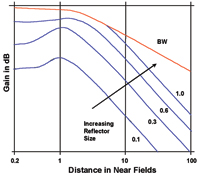DGS
Distance Gain Size
 DGS – Distance Gain Size – is a method of setting sensitivity or assessing the signal from an unknown reflector based on the theoretical response of a flat-bottomed hole reflector perpendicular to the beam axis. The DGS system was introduced by Krautkramer in 1958 and is referred to in German as AVG. A schematic of a general DGS diagram is shown in the Figure. The Y-axis shows the Gain and X-axis shows the Distance from the probe. In a general DGS diagram the distance is shown in units of Near Field and the scale is logarithmic to cover a wide range.
DGS – Distance Gain Size – is a method of setting sensitivity or assessing the signal from an unknown reflector based on the theoretical response of a flat-bottomed hole reflector perpendicular to the beam axis. The DGS system was introduced by Krautkramer in 1958 and is referred to in German as AVG. A schematic of a general DGS diagram is shown in the Figure. The Y-axis shows the Gain and X-axis shows the Distance from the probe. In a general DGS diagram the distance is shown in units of Near Field and the scale is logarithmic to cover a wide range. The blue curves plotted show how the amplitudes obtained from different sizes of disc shaped reflector (equivalent to a FBH) decrease as the distance between the probe and the reflector increases.
In the general diagram the size of reflector is given as a ratio between the size of the disc and the size of the crystal. The red curve shows the response of a backwall reflection. The ratio of the backwall to the crystal is infinity (∞).
Specific DGS curves for individual probes can be produced and so both the distance axis and the reflector sizes can be in mm.
If the sensitivity for an inspection is specified to be a disc reflector of a given size, the sensitivity can be set by putting the reflection from the backwall of a calibration block or component to the stated %FSH. The gain to be added can be then obtained by the difference on the Y-axis between the backwall curve at the backwall range and the curve of the disc reflector of the given size at the test range. If the ranges of the backwall and the disc reflector are different, then attenuation shall be accounted for separately. Alternatively, the curves can be used to find the size of the disc shaped reflector which would give the same size echo as a response seen in the flaw detector screen.
For more information on how to use a DGS diagram see:
BS EN ISO 16811:2014 Non-destructive testing – Ultrasonic testing – Sensitivity and range setting
Ultrasonic Flaw Detection for Technicians, J C Drury (Can be obtained from BINDT Bookstore.)
What the hec?! articles are not intended to be the definitive account on the topic or acronym in question. Readers’ comments and contributions are welcomed. Email: ndtnews@bindt.org